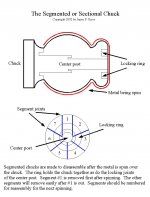I have seen a few parts like this - couldn't find an exact picture online, but this is close - just imagine if it the dome part was all one piece instead of having the perforated inner part... it can't be spun (can it?) from one piece because it would trap the form inside.
Would it be hydroformed using some sort of 3-piece mold that splits top/bottom and one half splits left/right?
Or perhaps a totally different method? I know it could be made in 2 pieces and welded... but I'm thinking something like a lamp shade where you would need absolutely no visible seam... wouldn't a welded seam always be visible if it was made in 2 parts?

Would it be hydroformed using some sort of 3-piece mold that splits top/bottom and one half splits left/right?
Or perhaps a totally different method? I know it could be made in 2 pieces and welded... but I'm thinking something like a lamp shade where you would need absolutely no visible seam... wouldn't a welded seam always be visible if it was made in 2 parts?




